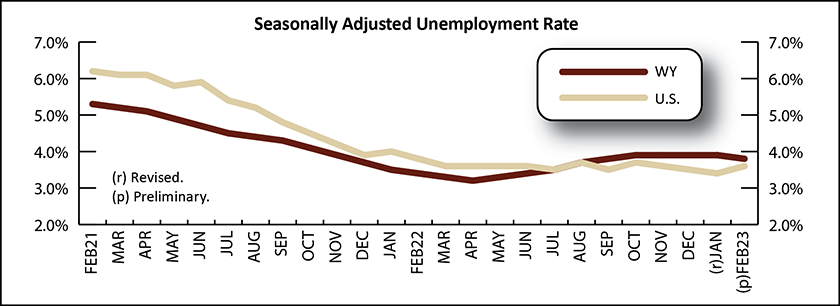Wyoming Labor Force Trends
April 2023 | Volume 60, No. 4
Click Here for PDF
Return to Table of Contents
Wyoming Unemployment Falls to 3.8% in February 2023
by: David Bullard, Senior Economist
The Research & Planning section of the Wyoming Department of Workforce Services reported that the state’s seasonally adjusted unemployment rate fell from 3.9% in January to 3.8% in February. Wyoming’s unemployment rate was slightly higher than the current U.S. rate of 3.6% and higher than its February 2022 level of 3.4%. From January to February, seasonally adjusted employment of Wyoming residents rose by 1,180 people (0.4%) suggesting that people were going back to work.
From January to February, unemployment rates fell in every county. Unemployment often decreases in February, as seasonal job gains occur in various sectors. Large decreases in unemployment were seen in Sweetwater (down from 5.3% to 4.7%), Platte (down from 4.5% to 4.0%), Albany (down from 3.8% to 3.4%), Big Horn (down from 5.2% to 4.8%), Campbell (down from 4.0% to 3.6%), Carbon (down from 4.8% to 4.4%), and Converse (down from 3.3% to 2.9%) counties.
From February 2022 to February 2023, unemployment rates rose in 15 counties, fell in five counties, and remained unchanged in three counties. The largest increases occurred in Niobrara (up from 2.7% to 4.7%), Lincoln (up from 3.5% to 4.1%), and Fremont (up from 4.4% to 5.0%) counties. Notable declines in unemployment were seen in Converse (down from 3.5% to 2.9%) and Campbell (down from 4.0% to 3.6%) counties.
Fremont County had the highest unemployment rate in February at 5.0%. It was followed by Sublette County and Big Horn County, each at 4.8%. The lowest unemployment rates were found in Teton County at 2.5%, Weston County at 2.8%, and Converse County at 2.9%.
Total nonfarm employment in Wyoming (not seasonally adjusted and measured by place of work) rose from 276,000 in February 2022 to 283,000 in February 2023, an increase of 7,000 jobs (2.5%).
R&P's most recent monthly news release is available at https://doe.state.wy.us/LMI/news.htm.




.svg)
 Wyoming at Work
Wyoming at Work